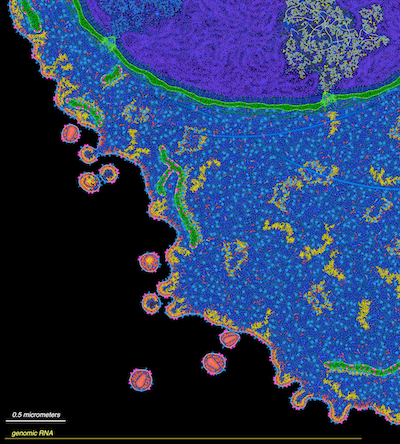Molecular Landscapes by David S. Goodsell
HIV-Infected Cell, 2022
Acknowledgement: Illustration by David S. Goodsell, B-HIVE Center, RCSB Protein Data Bank and Scripps Research. doi: 10.2210/rcsb_pdb/goodsell-gallery-047
Integrative illustration of an HIV-infected cell. The cell nucleus is at the top, with DNA in purple and nuclear membrane in green. The HIV genomic DNA (thin white strand at upper right) is integrated into the cell’s genome and is being transcribed into RNA (yellow) by RNA polymerases. The RNA is then transported through the nuclear pore to the cytoplasm. Some of the RNA is translated by cytoplasmic ribosomes to build gag and gag-pol proteins (red) and by ribosomes bound to the endoplasmic reticulum (green compartments in the cytoplasm) to build envelope glycoproteins (magenta). Other copies of the genomic RNA dimerize and are packaged into virions. Finally, gag and gag-pol associate with the cell membrane, capture the dimers of genomic RNA, and bud from the surface of the cell to form new virions. Inside these virions, the proteins mature, forming the distinctive cone-shaped capsid that will deliver the genomic RNA when the virus infects a new cell. The long yellow line at the bottom represents an extended genomic RNA.
This illustration was created as part of outreach activities at the B-HIVE Center. It is based largely on previous illustrations of eukaryotic cells and HIV life cycle, presented in two publications:
Goodsell, DS (2011) Eukaryotic Cell Panorama. Biochemistry and Molecular Biology Education 39, 91-101
Goodsell, DS (2015) Illustrations of the HIV Life Cycle. Current Topics in Microbiology and Immunology 389, 243-252




